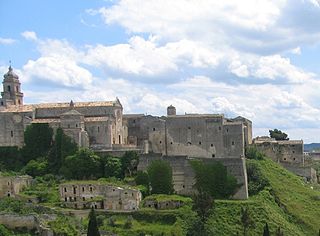
A prelate is a high-ranking member of the Christian clergy who is an ordinary or who ranks in precedence with ordinaries. The word derives from the Latin praelatus, the past participle of praeferre, which means 'carry before', 'be set above or over' or 'prefer'; hence, a prelate is one set over others.
An apostolic administration in the Catholic Church is administrated by a prelate appointed by the pope to serve as the ordinary for a specific area. Either the area is not yet a diocese, or is a diocese, eparchy or similar permanent ordinariate that either has no bishop or, in very rare cases, has an incapacitated bishop.

The Catholic Church in Peru is part of the worldwide Catholic Church, under the spiritual leadership of the Pope, the curia in Rome, and the Peruvian Episcopal Conference.

An apostolic prefect or prefect apostolic is a priest who heads what is known as an apostolic prefecture, a 'pre-diocesan' missionary jurisdiction where the Catholic Church is not yet sufficiently developed to have it made a diocese. Although it usually has an (embryonal) see, it is often not called after such city but rather after a natural or administrative geographical area.

A mission sui iuris, or in Latin missio sui iuris ; also spelled mission(s) sui juris), also known as an independent mission, can be defined as: "an ecclesial structure erected from a previous territory, with explicit boundaries, under the care of a religious community or other diocese, responding to a missionary exigency and headed by a superior nominated by the Holy See, under the aegis of the Congregation for the Evangelization of Peoples."

The diocese of Gravina and Montepeloso is a former ecclesiastical territory of the Roman Catholic Church in Apulia, southern Italy. Gravina is about 59 km (36 mi) southwest of Bari. Since 1986 it has formed part of the merged diocese of Altamura-Gravina-Acquaviva. Gravina in Apulia was the seat of the episcopal see from the ninth century.

The Archdiocese of Zamboanga is a Catholic archdiocese in the Philippines. Its present jurisdiction includes Zamboanga City, with suffragans in Basilan and Zamboanga Sibugay. It became Mindanao's first diocese in 1910, and was established as the second archdiocese of Mindanao in 1958. Today, the archdiocese covers a land area of 1,648 square kilometers and has a population of 442,345, of which 81 per cent are Catholics. The archdiocese includes 27 parishes and two quasi-parishes served by 49 diocesan and 18 religious priests. There are also 51 religious sisters working in the archdiocese.

The Diocese of Altamura-Gravina-Acquaviva delle Fonti is a Roman Catholic diocese in Apulia, southern Italy, created in 1986. In that year, the territorial prelature of Altamura e Acquaviva delle Fonti was united with the diocese of Gravina. The present diocese is a suffragan of the archdiocese of Bari-Bitonto.

The Roman Catholic Archdiocese of Santarém is a Latin Church metropolitan archdiocese in northern Brazil. It was a suffragan diocese in the ecclesiastical province of Belém do Pará until 6 November 2019.
The Roman Catholic Diocese of (Santíssima) Conceição do Araguaia is a Latin suffragan diocese of the Roman Catholic church, in the Ecclesiastical province of the Metropolitan of Belém do Pará in Brazil.

The Roman Catholic Archdiocese of Cuiabá is an archdiocese located in the city of Cuiabá in Brazil.

The Diocese of Guiratinga was a former ecclesiastical circumscription of the Catholic Church in Brazil, belonging to the Ecclesiastical Province of Cuiabá and the West II Regional Bishops' Council of the National Conference of Bishops of Brazil, being a suffragan of the Archdiocese of Cuiabá. The episcopal see is the Cathedral St. John the Baptist in the city of Guiratinga in the state of Mato Grosso.

The Roman Catholic Archdiocese of Porto Velho is an archdiocese located in the city of Porto Velho in Brazil.

The Roman Catholic Diocese of Roraima is a diocese located in the state of Roraima in the Ecclesiastical province of Manaus in Brazil.
The Diocese of Primavera do Leste–Paranatinga is a Latin suffragan Roman Catholic Diocese in the state of Mato Grosso, in the Ecclesiastical province of the metropolitan Archbishop of Cuiabá in Brazil.

The Roman Catholic Diocese of Rio Branco is a Latin suffragan see in the ecclesiastical province of the Metropolitan Archbishop of Porto Velho (Rondônia), in the upper Amazon River basin).

Carlo Caputo was a Roman Catholic priest. He was diocesan bishop of Monopoli and Aversa, then titular bishop of Nikomedia and from 1904 to 1907 apostolic nuncio to the Kingdom of Bavaria.
Moacyr Grechi was a Brazilian Roman Catholic archbishop.














